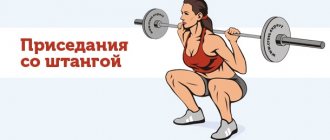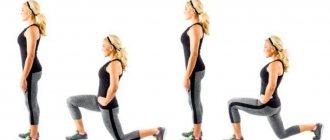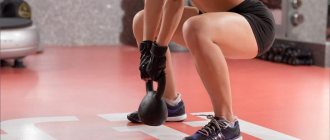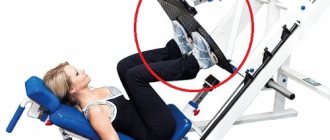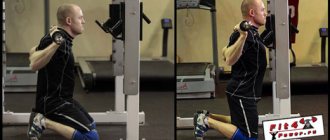The hack machine gained great popularity as soon as the category “fitness bikini” came into fashion. A number of trainers even write that you can’t get sane buttocks without doing a hack squat. But stubborn kinesiologists insist that people squat without machines just long enough until the equipment stops working. Is it really impossible for beginners to squat in a hack and what is the catch with this common exercise?
Execution technique
Initial position
- Stand on the platform of the machine in a stance that is comfortable for a regular squat. It should be possible to move your knees in alignment with your toes to the sides and lower your pelvis if you squat, pressing your back to the back;
- Next, the back is positioned against the back, the levers rest on the shoulders. It is necessary to activate the press, pulling it inward a little, but not completely removing the natural deflection of the spine;
- The head rests on the pillow with the back of the head, the shoulders are under the levers, and the restraints are removed by hand.
Movement
- It is necessary to begin to lower by bending the knee joint;
- The movement continues as long as it is possible to bend the knee and the feeling is comfortable;
- Some people squat parallel, others lower, it depends on the condition of the hip and knee joints. If there is no discomfort in them, the heels do not come off during movement, there is no reason not to squat to full amplitude;
- During movement, the hands hold the handles;
- From the bottom point, you should smoothly straighten your legs at the knee and hip joints, and then stand in the starting position;
- The number of repetitions is determined by the plan; if possible, the athlete should perform all repetitions using the same technique.
It's HACK SQUATS, baby!
Attention
- Amplitude and technique are highly dependent on the athlete's anthropometry. People with a long thigh and short lower leg are not recommended to squat on a back-to-back hack machine. They can do this facing the back, strongly moving the pelvis back to avoid injury to the knee joint. These people should ideally have their barbell squat technique established before they perform any bodybuilding variations. Requires the ability to control the body with muscles, and completely avoid overloading the spine;
- You can train your feet in different ways, but all this is for those who use relatively light weights in training and a reasonable approach. Any positioning of the feet will affect the knee ligaments and may contribute to their injury if this positioning is not natural for the person. It’s easy to determine what’s natural - you need to jump off a support or from a bench and look;
- It is also important how an athlete can squat with a barbell. If the amplitude in the joints does not allow you to sit with the mobile apparatus so that the pelvis is below the knees, perhaps this movement should not be performed at all.
- It is not recommended to lift your back from the back of the machine;
- You should not bend your lower back too much;
- It will be better if the heels also do not move and come off during the exercise.
Technique for performing hack squats using a barbell without a machine
Squats in a hack machine allow the athlete to reduce the axial load on the spine. This occurs due to the location of the guides and the moving platform at a certain angle to the horizon.
However, such equipment is not found in every gym. In order to minimize the load on the spinal column, you can perform squats with a barbell behind the back and in front of the athlete’s chest.
Behind the back
Technique:
- The projectile with the required load is placed on a flat surface. The athlete turns his back to him.
- While squatting, the athlete fixes the barbell with an overhand grip (the hands are facing the bar). The thumbs wrap around the bar and connect with the index fingers into a lock. It is not allowed to grab the bar with a “monkey” open grip.
- Next, you should begin the process of straightening the body at the knees and hip joint. It is important to move smoothly, without jerking.
- The process of lowering the bar is carried out until the moment at which the thighs become parallel to the floor.
The entire cycle of the described actions represents 1 complete repetition. The number of repetitions is determined by the athlete depending on physical fitness and training goals.
In front of the chest
Technique:
- The bar is fixed at the level of the shoulder girdle and rests on the athlete’s hands or deltoid muscles. The location of the projectile at this level allows you to expand your shoulders and bring your shoulder blades together. This creates additional protection for the spine.
- Lowering from the top position should be carried out smoothly. At the lowest point, the thighs are parallel to the floor.
- The rise to the starting point occurs without jerking.
The movements discussed represent one complete repetition.
Stop placement and load
The high and narrow position of the feet transfers the load to the biceps of the thighs and buttocks, but only people whose thigh is approximately the same length as the lower leg can safely squat in this position. If you are not one of them, you should be more careful in selecting exercises. It is better to take the option with your back to the gym, and not to the back of the machine;
“Sumo” allows you to shift the load to the medial heads of the quadriceps, but in most cases this technique also includes the adductor muscles;
The anatomical stance distributes the load between the quadiceps and biceps relatively evenly.
Leg exercises. Hack squats.
Alternatives to hack squats and barbell work
How can you replace hack squats in the initial stages? This is an important question if you can’t work with a barbell and don’t have a comfortable simulator. Get ready to work your legs. Even if you have nothing, you can start working with your own weight and pump up your muscles, stretch your ligaments, and prepare your joints for stress.
Place your legs wider than shoulder-width apart, feet parallel, heels pressed to the ground. In a half squat, slowly transfer your weight from one leg to the other. Move smoothly, without jerking. In this case, the duration of the exercise is important. The first attempt will knock you off your feet in about 5 minutes. Gradually increase the exercise time to 20 minutes, increase the depth of the squat. Watch your buttocks and do not stick out your butt. After a couple of months of training, you will have calves of steel, beautiful powerful thighs and well-developed buttock muscles.
After completing the exercise, be sure to stretch and massage your legs, starting from your feet. Otherwise, the next day you will not be able to get up on your feet without severe muscle pain. An alternative performance of squats with body weight transfer is needed to prepare for classic hack squats.
What muscles work
The main movers here are the quadriceps and hamstrings. With a good amplitude, the gluteal muscles are included in the movement. The calves and soleus also work in this squat variation. It is a mistaken belief that the Hack squat is for beginners. An ordinary person with an office job does not have the necessary mobility in the ankles and hip joints and therefore should not squat in the Hakka.
The error occurs because the simulator turns off the abs and back. Many people find it easier to squat this way. However, such a squat is not natural for a person. In everyday life, we sit down and stand up with a slight tilt of the body forward with contracted back muscles. We need to activate these muscles to maintain balance.
The back is turned off not to prevent injury or for rehabilitation, but in order to achieve bodybuilding goals. With the help of the Hack squat, they want to “turn on” the legs and “turn off” the transverse abdominal muscles and latissimus dorsi muscles as much as possible from the process. This is necessary in order to get a load that does not increase the width of the waist. This is all true only for professional athletes, their training volumes and means of recovery. But an ordinary amateur who came to strengthen his muscles and improve his appearance, but not become a bodybuilder, should not worry about this. He is still not destined to “swing his waist” with ordinary strength exercises.
Pros and cons of the hack squat
Typically, such questions are asked by people who study without a coach or with an inexperienced instructor. The free weight squat is fundamentally different from the hack machine in terms of biomechanics. In the squat, the weight of the barbell is distributed relatively evenly between the back and hips, especially in a technique that is safe to lift.
In a hack machine, it completely puts pressure on the shoulders, is projected onto the hips and puts quite a significant load on the knees.
The pros and cons of gakka can be summarized as follows:
- The variation is good for bodybuilding purposes. Allows you to load your legs with reduced “recoil” to the back, and get a fairly high-quality workout without the use of huge weights and the metabolic stress that accompanies such practice;
- The exercise can be used for those who are trying to master the squat with a vertical back, but cannot maintain balance with a barbell placed on top of the trapezius. At the same time, such a person can bend his hips and knees in principle, and sit in a full squat with a low barbell;
- The movement is suitable for those who need something to “finish off” their legs after regular squats, but the leg press is not suitable due to an unstable lower back position or some other similar factor;
- The machine is considered safer for performing drop sets and supersets, but is not intended for squatting with rubber shock absorbers. Although for a version of the squat with a rubber shock absorber around the hips, the hack is more suitable than the barbell, as it allows you to activate the hip;
- A significant disadvantage of Hakka is that it cannot replace squats with a barbell on the back and chest, but it is often used as a replacement, so people who practice such things rarely achieve significant progress. They may suffer both because of their ignorance and because the trainer convinced them of the need to “isolate the legs and exclude the back from the movement.” Let us remind you that you should do this only after your back muscles have strengthened. It is absolutely not necessary to perform Hakka squats with huge weights, the same applies to the barbell. But harmonious development of the body is achieved only by combinations of basic movements with free weight and exercises in simulators.
Common hack squat mistakes
Up to 90% of all mistakes when performing squats in a hack machine are made due to incorrect selection of the weight of the projectile.
A load that does not correspond to the athlete’s capabilities leads to the following violations:
- Separation of the heels of the feet from the supporting plane . An error occurs in a situation where the power of the quadriceps is not enough to lift to the top point. In this case, the novice athlete’s body tries to include additional reserves in the form of the gluteal and back muscles.
- Bringing the knees together . The quadriceps muscle is the strongest group in the lower body. This is especially true for untrained athletes. With a high load, a shift occurs towards strong muscles and the knees of the practitioner are brought to the center so that the lateral head can perform a greater amount of work.
- The separation of the lumbar spine from the supporting platform is associated with the body's need to include additional fibers in order to cope with the exorbitant weight of the burden. Also, this error can occur as a result of the athlete’s insufficient flexibility in the hip joint or the anatomical features of the attachment of the muscles of the back of the thigh.
- Uncontrolled downward movement. Often combined with an incorrect upward push. When performing the exercise, the foot should rest completely on the platform, and the load should be distributed over its entire surface. In the case when the weight of the weight exceeds the permissible limits, the athlete is not able to control the position of his own body, both during the negative and positive phases.
Among novice athletes, a number of mistakes arise due to ignorance of the basics of human physiology and the nuances of the design of the simulator:
- Rest at the bottom or top point of the trajectory. In the first case, the load on the knee joint increases significantly. In the second, there is a waste of time.
- Head turns. The spine runs through the entire human body. Although the hack squat is not subjected to axial load, the muscles of the upper body experience strong static tension. The slightest sudden movements can lead to injury.
- Wrong breathing.
- The back is not pressed tightly against the back of the machine. In this case, the main advantage of the simulator is lost and the spine begins to experience significant deformation.
Preparing for the exercise
Ideally, a student should be able to squat without a barbell into a full squat, perform a goblet squat, and squat with a barbell on the front and back. The first exercise in the Hakk plan happens only in one case - a person is engaged in bodybuilding, not fitness, and came to purposefully pump up his legs without including his back.
If the Hack squat is the first exercise of the plan, you should actively warm up. First you need to roll out your hips and buttocks on a foam roller, after MFR you need to walk on a treadmill or pedal an exercise bike. And only after this you need to start doing a special warm-up.
The machine is quite heavy on its own, so beginners will have to rule out the option of immediately moving into the machine and starting to squat. Their task is to squat for a couple of sets without weight, and only then start working on the machine.
Otherwise, it is not recommended to immediately start with working weight; you need to do 1-4 warm-up approaches. The greater the working weight, the longer the warm-up will be. If submaximal weights are used, and this is not the first exercise, warm-up approaches should still be done.
Classic hack squats
Performed without a machine, with a barbell . Allows you to “draw” the thigh muscles well.
- Stand with your back to the barbell.
- Squat down and grab the bar. A straight grip is recommended.
- Arms and back are straight. Rise up at an average pace, straighten your knees.
- As you move down, be careful not to let your knees go past your toes.
This exercise can also be performed on a machine, which makes the task easier by relieving the strain on your back.
Inclusion in the program
Many people believe that auxiliary exercises in the plan are not needed, and that it is enough to do one base. This is not true.
Working in a hack trainer can:
- Help with the development of lagging legs if the athlete squats with significant involvement of the back;
- Strengthen your quadriceps and hamstrings;
- Improve the neuromuscular connection and accustom the person to the movement itself - bending the legs at the knee joint. This is practiced if a person does not have problems with flexibility, but does not sit up due to the lack of neuromuscular connection
Like any other work in simulators, the hack is included in training as needed, that is, in order to achieve a specific goal - improve the squat or load the legs more.
A variation of the exercise is the reverse Hack squat, that is, a movement in which the pelvis is pulled back and the face is directed towards the back of the machine. For many, this exercise is more reminiscent of a forward bend with a barbell, but it is often used as a staple in women's training.
Squats in the HAKK-simulator: technique and nuances
Foot placement options
Hack squats can be performed with 4 basic leg positions while maintaining the classic movement technique. The position of the feet and the distance between them may differ depending on the anatomical characteristics of the athlete. But the general recommendations and techniques used remain unchanged.
| Narrow foot placement. | Feet placed as far forward as possible | This option allows you to load the lateral head of the quadriceps femoris muscle |
| Feet nearby. At the lowest point, the knees “cover” the tips of the fingers. | This positioning of the legs allows you to shift the force from the front to the back surface of the leg. | |
| Shoulder width apart. | The feet are turned outward or parallel. | All 4 quadriceps bundles are equally involved in the work. |
| Wide stance | The legs are placed at the edge of the platform. The socks are turned outward. | The muscles of the inner thigh are involved in the work. |
Leg training including hack machine
Attention – working “in failure” is recommended only for those who are engaged in bodybuilding and can use a variety of recovery means. For amateurs and beginners, conventional set-repetition schemes are sufficient.
Such training usually includes minimal isolation. The athlete starts with a barbell squat, then moves on to the Gakku, then performs 1 isolation exercise for the hamstrings and quadriceps.
If the workout is focusing on the back of the thighs, it is recommended to start with the deadlift version, and then turn on the hack machine.
Interesting fact! The simulator was invented by the Russian athlete and trainer Georg Hackenschmidt and the machine became one of the first leg simulators known to mankind.



